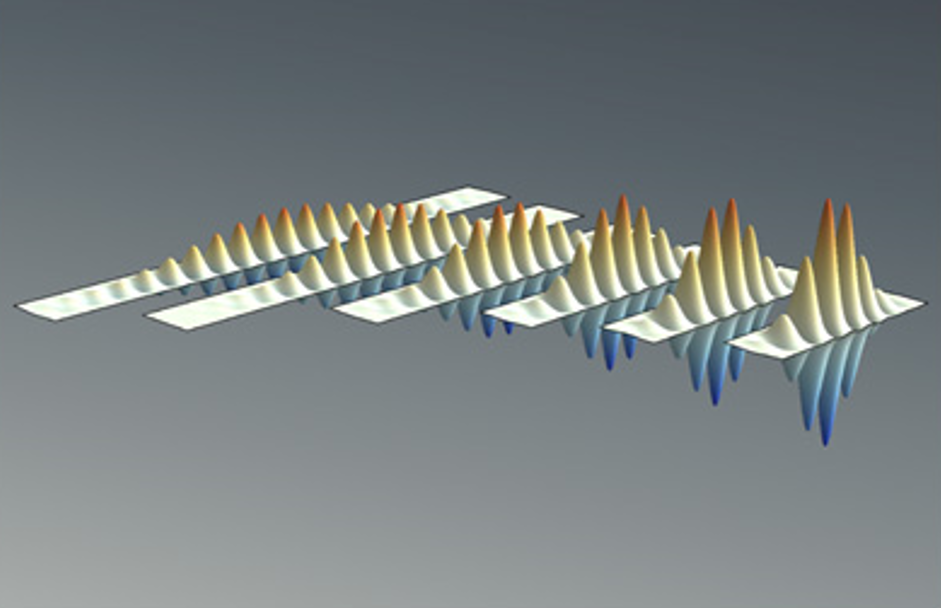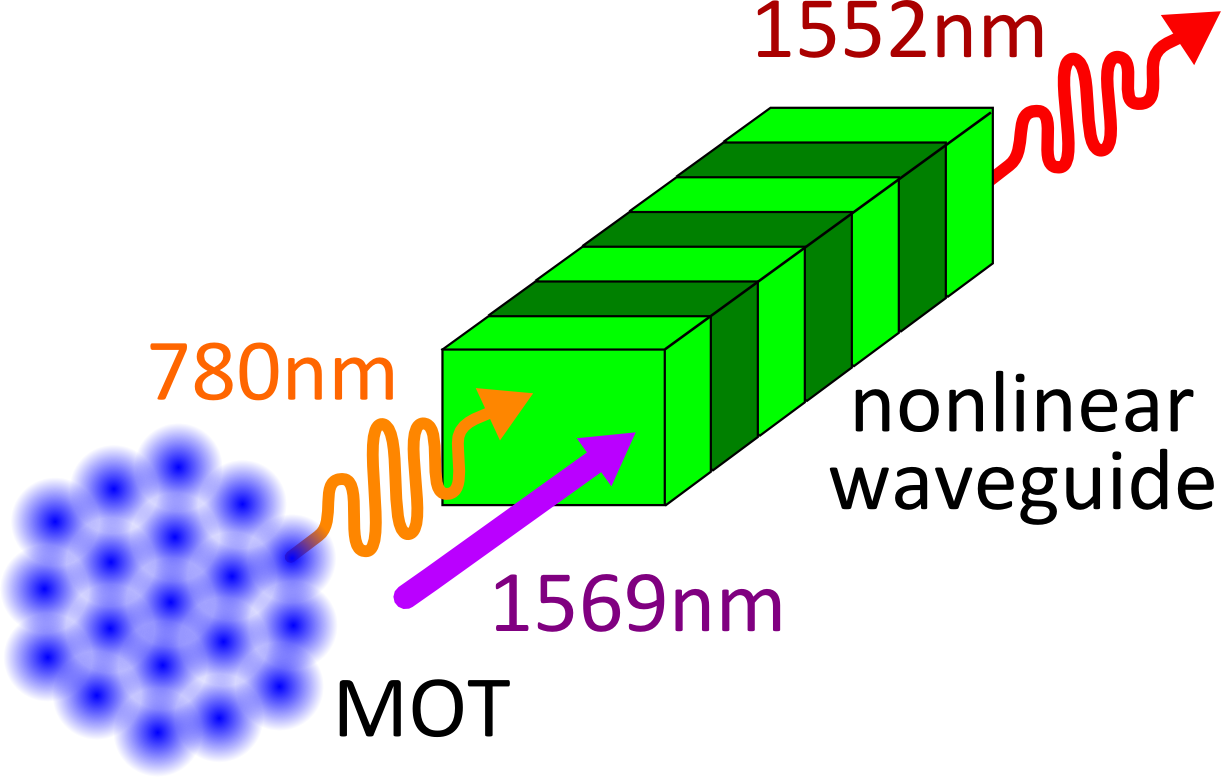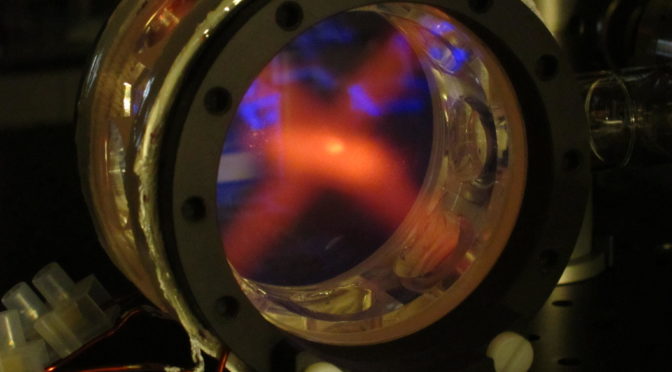Cold atomic ensembles are currently one of the most advanced systems for the quantum control of light matter interaction at the single excitation level. Single collective spin excitations (so called super atoms) can be created in a heralded fashion and efficiently transferred into a single photon field, thanks to a collective interference between all the emitters. We are investigating various protocols to create, manipulate and transfer to light single collective spin excitations.
People in this Project:
Research Details
Photonic quantum state transfer to between hybrid matter systems
(Description pending)
N. Maring, P. Farrera, K. Kutluer, M. Mazzera, G. Heinze and H. de Riedmatten, Nature 551, 485–488 (2017)
Light-matter entanglement
 Light-matter quantum states combine the advantage of long distance transmission of “light states” with the storage and processing capabilities of “matter states”. A particularly interesting subclass are entangled quantum states, which defy fundamental concepts of nature such as local realism and which have found important applications in the fields of quantum cryptography, computation or metrology.
Light-matter quantum states combine the advantage of long distance transmission of “light states” with the storage and processing capabilities of “matter states”. A particularly interesting subclass are entangled quantum states, which defy fundamental concepts of nature such as local realism and which have found important applications in the fields of quantum cryptography, computation or metrology.
In this work we studied the generation of entanglement between a photonic time-bin qubit and a collective spin excitation in a laser-cooled atomic ensemble. Photonic time-bin qubits consist of photons that are in a quantum superposition between two time intervals. This encoding is very promising for quantum communication purposes thanks to its intrinsic robustness while propagating through optical fibers. Collective spin excitations in laser-cooled atoms have two main advantages: they exhibit very long lifetimes and they can be efficiently transferred into single photons. The entanglement between these two different objects could be used for instance, for the entanglement distribution of between remote matter objects.
P. Farrera, G. Heinze and H. de Riedmatten, Phys. Rev. Lett. 120, 100501 (2018)
This type of entanglement was also tested using human random numbers to decide the measurement basis settings. This was part of the Big Bell Test collaborative project, which among other goals, aimed to test the freedom-of-choice loophole in Bell tests.
The BIG Bell Test Collaboration, Nature 557, 212–216 (2018)
Photon source for Rydberg-mediated photon-photon interactions
(Description pending)
E. Distante, P. Farrera, A. Padrón-Brito, D. Paredes-Barato, G. Heinze and H. de Riedmatten, Nature Communications 8, 14072 (2017)
Heralded single photons with highly tunable temporal wave shape
 The frequency spectrum of any light pulse depends on its temporal envelope. In the context of single photons, being able to tailor their spectrum is crucial to efficiently interface them with different matter quantum systems. That is because typically each sort of atomic system exhibits a unique energy structure which requires spectrally matched photons for optimal light-matter interaction.
The frequency spectrum of any light pulse depends on its temporal envelope. In the context of single photons, being able to tailor their spectrum is crucial to efficiently interface them with different matter quantum systems. That is because typically each sort of atomic system exhibits a unique energy structure which requires spectrally matched photons for optimal light-matter interaction.
In this work we studied the temporal waveshape tunability of single photons generated by laser-cooled atoms. Based on a four-wave-mixing scheme, we managed to generate single photons with durations ranging from around 10ns to 10us. This was enabled by the intrinsic storage capability of long-lived coherent spin-excitations in our system. We also showed the tunability of the photon profile by generating photons with two non-standard wave shapes: a double-peaked and a rising exponential profile. The first one plays an important role in the context of quantum information as photonic time-bin qubit, while the second one has been shown to be the ideal shape to interact with several atomic quantum systems.
P. Farrera, G. Heinze, B. Albrecht, M. Ho, M. Chávez, C. Teo, N. Sangouard and H. de Riedmatten, Nat. Commun. 7, 13556 (2016)
Manipulating single collective spin excitations
 Single collective spin excitations (also known as spin waves) are objects relying on the concept of quantum superposition. They consist of an ensemble of atoms with a single spin excitation delocalized over the whole ensemble. This forms an entangled state of many particles which is sometimes also known as a superatom. Apart from their fundamental interest, spin waves are also essential in the field of quantum information because they are the common form in which quantum bits are stored in ensemble based photonic quantum memories. Their good point, is that they can be efficiently converted into single photons, thanks to constructive interference between all the atomic emitters.
Single collective spin excitations (also known as spin waves) are objects relying on the concept of quantum superposition. They consist of an ensemble of atoms with a single spin excitation delocalized over the whole ensemble. This forms an entangled state of many particles which is sometimes also known as a superatom. Apart from their fundamental interest, spin waves are also essential in the field of quantum information because they are the common form in which quantum bits are stored in ensemble based photonic quantum memories. Their good point, is that they can be efficiently converted into single photons, thanks to constructive interference between all the atomic emitters.
In this experiment, we controlled the phase of single spin waves using a magnetic gradient. The obtained results represent an example of the wave-particle duality applied to these objects. In addition, we showed that this manipulation can enable the operation of a photon pair source quantum memory in a temporally multimode fashion. This was demonstrated by creating photon – spin wave pairs in two different temporal modes, and subsequently converting the excitations into other photonic modes also separated in time.
B. Albrecht, P. Farrera, G. Heinze, M. Cristiani and H. de Riedmatten, Phys. Rev. Lett. 115, 160501 (2015)
Frequency conversion of non-classical light emitted by a cold atomic quantum memory
 Optical quantum memories usually emit photons in the visible-near IR region of the electromagnetic spectrum. Translating back and forth the wavelength of these photons towards the telecom window around 1550nm can be useful for two reasons. First, light at telecom wavelengths exhibits the lowest possible losses in optical fibers and second, it allows to connect quantum memories of different atomic species, dealing with light at different wavelengths.
Optical quantum memories usually emit photons in the visible-near IR region of the electromagnetic spectrum. Translating back and forth the wavelength of these photons towards the telecom window around 1550nm can be useful for two reasons. First, light at telecom wavelengths exhibits the lowest possible losses in optical fibers and second, it allows to connect quantum memories of different atomic species, dealing with light at different wavelengths.
In these experiments we studied the frequency conversion (from 780nm to 1552nm) of the single photons emitted by a quantum memory based on laser-cooled Rubidium atoms. The conversion process applied difference frequency generation, and took place in a non-linear waveguide. Thanks to the high conversion efficiency and the low noise of the quantum frequency conversion device, we managed to show that the non-classical behaviour of the light emitted by the quantum memory is preserved after the frequency conversion of the photons. This is an important step towards the connection of different quantum memories through telecommunication channels.
P. Farrera, N. Maring, B. Albrecht, G. Heinze and H. de Riedmatten, Optica 3, 1019 (2016)
B. Albrecht, P. Farrera, X. Fernandez Gonzalvo, M. Cristiani and H. de Riedmatten, Nature Commun. 5,3376 (2014)
Funding:

